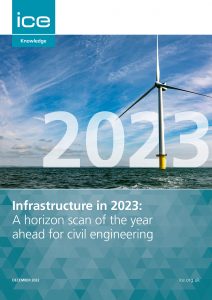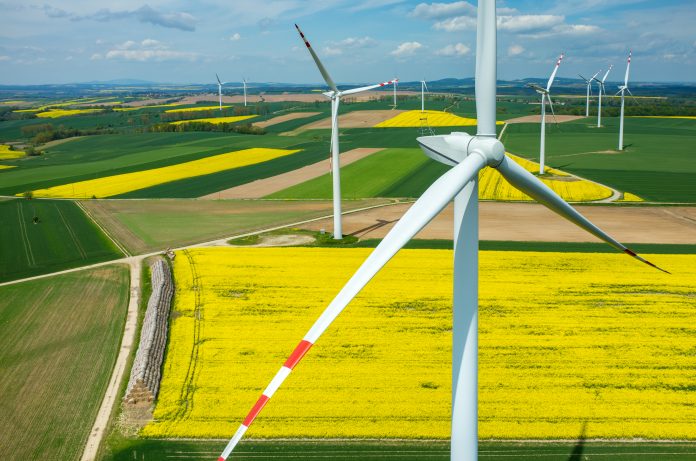Mark Hansford, director of engineering knowledge at the Institution of Civil Engineers, examines the key themes for infrastructure in 2023, from decarbonisation and resilience to transport and digitalisation
How we plan, build and operate infrastructure in the UK is likely to change dramatically in the next few years. This was the consensus when we asked members of the Institution of Civil Engineers to identify the key trends and challenges facing infrastructure in 2023 and beyond. Their predictions span a wide variety of disciplines, from energy to flooding and transport to tunnelling.
This is the second year that we have produced a horizon scan report, and it’s clear the pace of change across the industry is increasing.
The cost-of-living crisis and global economic pressures loom large in this year’s report. It is clear there will be less money to go around for infrastructure projects and a greater emphasis on productivity and using technology and data – particularly the sharing of data between projects – to drive efficiencies.
Another theme that recurs throughout the report is collaboration – both between civil engineers but also with those from other disciplines such as town planners, architects, environmental specialists and those working in the technology sector.
This is where the Institution can help – our year-round schedule of events and our enduring partnerships ensure that civil engineers are speaking to and collaborating with the wider world. Our recent report, Financing Low-Carbon Infrastructure, looked at how the finance and engineering sectors can work together more closely.
Some of the other major themes for in 2023 included:
2030 net zero targets
The government has a major net zero target to meet by 2030 (not just the better-publicised 2050 mark) and the report calls for “huge strides” in decarbonising our infrastructure.
Specifically, the authors call for consistent, valid metrics to allow a common understanding of whole-life carbon impacts. This means, for example, a single database to store the carbon impacts of construction and infrastructure projects so that designers and engineers can check what has come before and accurately model the carbon impact on their projects.
They also suggest that all public sector projects should have short-term budgets or goals for carbon reduction to set the pace of change that is needed to meet the net zero targets.
Resilient infrastructure in 2023
The vulnerability of the infrastructure systems we all depend on was highlighted last summer as railway tracks buckled and roads surfaces melted in the heat. The disruption caused by heavy rain or snow are more familiar to us.
The report finds that resilience “will be a huge topic for the rest of this decade” and says that engineers will need to go beyond current building codes and standards to ensure what they build can withstand future weather extremes. It also looks forward to the UK government’s adaptation plan and update to the Green Book, expected later this year.
Sustainable drainage
Some 600,000 properties could face a high risk of flooding from surface water by mid-century, according to a recent report from the National Infrastructure Commission. Providing sustainable drainage systems will be a key consideration for all developers in 2023 and beyond.
At time of writing, the government is deciding whether to implement Schedule 3 of the Flood & Water Management Act, removing developers’ automatic right to connect to public sewers. Regardless of what it decides, the importance of providing green spaces, porous surfaces and other drainage solutions is growing all the time.
The transport sector in 2023
Policies that encourage electric and self-driving vehicles on our roads and an increasing emphasis on cycling and walking in our towns and cities will be key themes of 2023.
Almost two-thirds of local authorities in England have pledged to hit net zero carbon emissions from their operations by 2030, and greener transport systems will be an important lever for achieving this. This is likely to mean an emphasis on cycling and walking, more reliable bus services and infrastructure for greener transport such as electric car charging.
The creation of Great British Railways could also make track works quicker and cheaper.
National strategy for the digitalisation of the built environment
The report calls for a national strategy for the digitalisation of the built environment, noting that progress to date has been piecemeal and has occurred in siloes. Digital twins, robotics, artificial intelligence and virtual reality are real-world technologies, but they are not being used to their full potential.
Our members believe technology has huge potential to transform construction processes to significantly reduce the wasteful practices we see on many sites around the world. It also can help us to store and share data between projects more effectively, and investors and clients have a “critical” role to play in encouraging this collaboration.
The Infrastructure in 2023 report is available to read now on the ICE website.

Mark Hansford
Director of engineering knowledge
Institution of Civil Engineers














